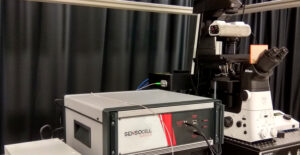The study of subcellular mechanics is essential to understand how, among other biological processes, cells proliferate, migrate or differentiate. Indeed, cells, decode mechanical signals via the presence of force-sensitive subcellular and molecular elements that transduce mechanical information into specific signaling pathways controlling cell behavior, cell fate, and cell mechanics. Now, these kind of studies are possible with a new protocol using SENSOCELL optical tweezers developed by the Neurophotonics & Mechanical Systems Biology lab at ICFO and the Ruprecht lab at CRG.
Sounds interesting? Then check their latest article published at JOVE Journal and keep reading!
Direct Force Measurements of Subcellular Mechanics in Confinement using Optical Tweezers.
Frederic Català-Castro, Valeria Venturini, Santiago Ortiz-Vásquez, Verena Ruprecht, Michael Krieg. J. Vis. Exp.(174), e62865, doi:10.3791/62865 (2021).
In this article, the authors describe in detail a new method to measure the forces and material properties that shape the cell nucleus inside living cells, exemplified on adherent cells and mechanically confined cells. According to the authors, the presented method is straightforward and can easily be extended to investigate the mechanics of other subcellular compartments, e.g., mitochondria, stress-fibers, and endosomes.
A unique setup combining optical tweezers, direct force spectroscopy and spinning disk confocal imaging.
The measurements can be performed non-invasively with optical traps inside cells, and the forces are directly accessible through Impetux’s exclusive technology based on calibration-free detection of light momentum. This allows measuring the mechanics of the nucleus independently from cell surface deformations and allowing dissection of exteroceptive and interoceptive mechanotransduction pathways. Importantly, the trapping experiment can be combined with optical microscopy to investigate the cellular response and subcellular dynamics using fluorescence imaging of the cytoskeleton, calcium ions, or nuclear morphology.
To deep into the details of this work have a look at the article here.
Enjoy the reading!
Congratulations to the authors!
📌If you are interested in how our optical tweezers system: SENSOCELL can be used for cell micro-rheology measurements, cell nucleus indentation experiments, neuron mechanosensation studies, among others applications, you can have a look at the application section or directly contact us.





